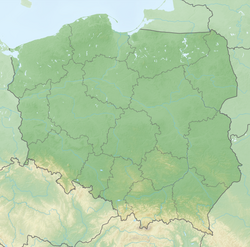Battle of Punitz
| date | November 7, 1704 |
|---|---|
| place | Punitz , Poland |
| output | Victory of the Swedes |
| Parties to the conflict | |
|---|---|
| Commander | |
| Troop strength | |
| 3,000–7,000 cavalrymen |
4900 men : 4000 infantrymen 900 cavalrymen |
| losses | |
|
around 100–150 dead and wounded |
about 500 dead, wounded and prisoners |
1st phase: Swedish dominance (1700–1709)
Riga I • Jungfernhof • Varja • Pühhajoggi • Narva • Pechora • Düna • Rauge • Erastfer • Hummelshof • Embach • Tartu • Narva II • Wesenberg I • Wesenberg II
Arkhangelsk • Lake Ladoga • Nöteborg • Nyenschanz • Neva • Systerbäck • Petersburg • Vyborg I • Porvoo • Neva II • Koporje II • Kolkanpää
Vilnius • Salads • Jacobstadt • Walled Courtyard • Mitau • Grodno I • Olkieniki • Nyaswisch • Klezk • Ljachavichy
Klissow • Pułtusk • Thorn • Lemberg • Warsaw • Posen • Punitz • Tillendorf • Rakowitz • Praga • Fraustadt • Kalisch
Grodno II • Golovchin • Moljatichi • Rajowka • Lesnaja • Desna • Baturyn • Koniecpol • Weprik • Opischnja • Krasnokutsk • Sokolki • Poltava I • Poltava II
2nd phase: Sweden on the defensive (1710–1721)
Riga II • Vyborg II • Pernau • Kexholm • Reval • Hogland • Pälkäne • Storkyro • Nyslott • Hanko
Helsingborg • Køge Bay • Gulf of Bothnia • Frederikshald I • Dynekilen Fjord • Gothenburg I • Strömstad • Trondheim • Frederikshald II • Marstrand • Ösel • Gothenburg II • Södra Stäket • Grönham • Sundsvall
Elbing • Wismar I • Lübow • Stralsund I • Greifswalder Bodden I • Stade • Rügen • Gadebusch • Altona • Tönning II • Stettin • Fehmarn • Wismar II • Stralsund II • Jasmund • Peenemünde • Greifswalder Bodden II • Stresow
The Battle of Punitz was a battle of retreat between Saxon and Swedish troops on November 7, 1704 near Punitz in the course of the Great Northern War . The Swedes under the command of Charles XII. were able to win the battle, but not prevent the retreat of the Saxon corps over the Oder under the command of Johann Matthias von der Schulenburg .
prehistory
After the Polish king's election, Charles XII marched. to Lemberg , which he reached on August 7, 1704. August II , who camped in Sendomir , took advantage of the king's absence and marched to Warsaw , occupied the city and captured 1500 Swedes. When Charles XII. approached the city again in October, August II withdrew to Krakow . General Schulenburg tried to reach Saxony via the Oder with 8,000 infantry and 1,000 cavalry. Charles XII. pursued this corps and caught up with Punitz on November 7th.
course
Schulenburg had twelve battalions and four squadrons, a total of only 4900 soldiers, whom he hurriedly brought into battle position. The left wing of the Saxons was covered by the village of Punitz. The right side was protected by an impassable swamp. There was a ditch in front of the center, behind which additional wagons were placed. Schulenburg had cannons positioned between the cars. Although it was already late, Charles XII began. the attack. He had four regiments of dragoons . Five other regiments could no longer reach the battlefield on time, so that the king of a total of 7,000 riders was only able to muster 3000 men at the beginning. First the Swedes attacked the Saxon cavalry. This was messed up. The Saxon infantry had to make way for the retreating Saxon cavalry pursued by the Swedes. The Saxon infantry was able to reposition itself despite the escape of the cavalry and initially withstood the attacks of the Swedes. The lines of the Saxons could be broken three times by the Swedes. When the five late regiments of the Swedes finally arrived on the battlefield, the fallen darkness and the exhaustion of the soldiers from the long marches prevented a renewed attack on the Saxon lines. When Schulenburg noticed that no further attacks were taking place, he had each battalion formed squares and retreated to nearby Punitz. Charles XII. ordered some troops to cut off the route of retreat, but these troops missed the way due to the darkness, so that the Saxons were able to withdraw successfully. The next morning the Swedes marched into the village and took wounded Saxons prisoner there, and captured the train and three cannons.
Results
The Saxons had a total of 500 dead, wounded and prisoners as well as three guns to mourn, while the Swedish losses are estimated at 100 to 300, according to other sources even at 1,500 dead and injured. Despite the losses and the heavy attack by the Swedes, the Saxon corps managed to cross the Oder. Charles XII. pursued the Saxons to Glogau , then returned to Poland and set up camp near Ravitz on the Saxon border. With this he threatened Saxony and cut it off from August II, who was in Poland. He stayed there for the next eight months.
Trivia
- A wooden cross was later erected near the village of Janischewo , north of Punitz , which is said to represent the fallen on both sides of the battle. However, this is doubted by most researchers, as there are no clear indications of the battle to be found on the cross.
literature
- Gustavus Adlerfeld, Carl Maximilian Emanuel Adlerfelt, Henry Fielding: The military history of Charles XII, King of Sweden, Volume 2, London 1740, pp. 69ff
- Zbigniew Anusik: Karol XII , Wrocław-Warszawa-Kraków 2006 (opis bitwy pp. 130-131).
Individual evidence
- ↑ Zbigniew Anusik, Karol XII , p. 131
